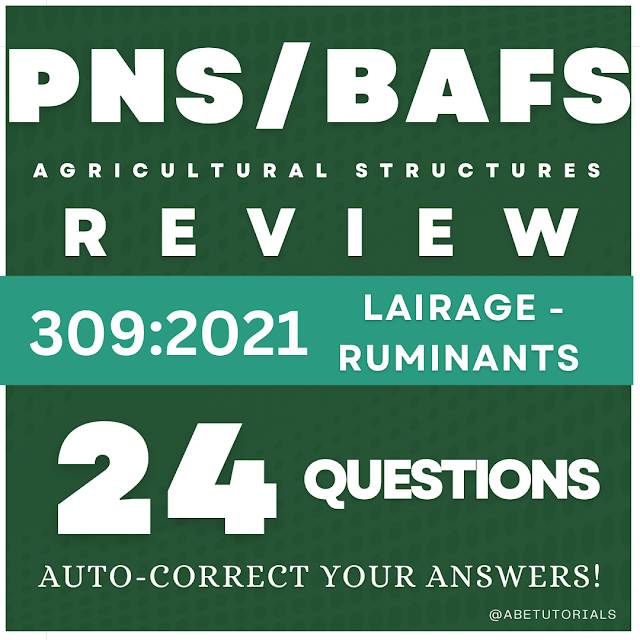PNS/BAFS 309: 2021 – AGRICULTURAL STRUCTURES – LAIRAGE - RUMINANTS
RED (WRONG ANSWER) / GREEN (CORRECT ANSWER)
Question 1: What is the passageway for animals that connects the lairage to the slaughtering area?
A) Ramp
B) Chute
C) Corridor
D) Tunnel
Explanation: https://amtec.uplb.edu.ph/wp-content/uploads/2021/07/PNS-309-Agricultural-Structure-Lairage-Ruminants.pdf
Question 2: What is an animal that is unable to move or stand called?
A) Downer
B) Sick
C) Lame
D) Injured
EXPLANATION: https://amtec.uplb.edu.ph/wp-content/uploads/2021/07/PNS-309-Agricultural-Structure-Lairage-Ruminants.pdf
Question 3: What is the term for killing an animal as soon as possible to prevent further suffering, such as with downers?
A) Humane Slaughter
B) Immediate Slaughter
C) Emergency Slaughter
D) Quick kill
EXPLANATION: https://amtec.uplb.edu.ph/wp-content/uploads/2021/07/PNS-309-Agricultural-Structure-Lairage-Ruminants.pdf
Question 4: What is the uppermost surface of a floor once construction has been completed called?
A) Finished Floor Line
B) Floor surface
C) Floor level
D) Floor base
Explanation: https://amtec.uplb.edu.ph/wp-content/uploads/2021/07/PNS-309-Agricultural-Structure-Lairage-Ruminants.pdf
Question 5: What is the designated compartment in the lairage used to separate sick and injured animals identified at the unloading area and during ante mortem inspection called?
A) Sick bay
B) Isolation Pen
C) Holding pen
D) Medical pen
Explanation: https://amtec.uplb.edu.ph/wp-content/uploads/2021/07/PNS-309-Agricultural-Structure-Lairage-Ruminants.pdf
Question 6: Where can animals rest prior to slaughter?
A) Lairage
B) Slaughtering area
C) Holding area
D) Rest pen
Explanation: hhttps://amtec.uplb.edu.ph/wp-content/uploads/2021/07/PNS-309-Agricultural-Structure-Lairage-Ruminants.pdf
Question 7: Which of the following refers to cattle, carabao, and buffalo?
A) Small ruminant
B) Large ruminant
C) Livestock
D) Ungulates
Explanation:https://amtec.uplb.edu.ph/wp-content/uploads/2021/07/PNS-309-Agricultural-Structure-Lairage-Ruminants.pdf
Question 8: What is the weight of an animal prior to slaughter called?
A) Carcass weight
B) Live weight
C) Dead weight
D) Pre-slaughter weight
Explanation:https://amtec.uplb.edu.ph/wp-content/uploads/2021/07/PNS-309-Agricultural-Structure-Lairage-Ruminants.pdf
Question 9: What is a premises called that is approved and registered by the competent authority for the slaughtering of food animals for human consumption?
A) Slaughterhouse / Abattoir
B) Meat Processing Plant
C) Animal processing facility
D) Livestock market
Explanation:https://amtec.uplb.edu.ph/wp-content/uploads/2021/07/PNS-309-Agricultural-Structure-Lairage-Ruminants.pdf
Question 10: What refers to sheep, goat, and deer?
A) Large ruminant
B) Feral animals
C) Small ruminant
D) Herbivores
Explanation:https://amtec.uplb.edu.ph/wp-content/uploads/2021/07/PNS-309-Agricultural-Structure-Lairage-Ruminants.pdf
Question 11: What is an animal showing physical or physiological abnormalities that may require further inspection and/or examination called?
A) Diseased animal
B) Suspected animal
C) Abnormal animal
D) Conditional animal
Explanation:https://amtec.uplb.edu.ph/wp-content/uploads/2021/07/PNS-309-Agricultural-Structure-Lairage-Ruminants.pdf
Question 12: What term refers to the means of transporting animals, including trucks, trailers, or utility vehicles?
A) Animal carrier
B) Livestock truck
C) Transport cage
D) Transport vehicle
Explanation:https://amtec.uplb.edu.ph/wp-content/uploads/2021/07/PNS-309-Agricultural-Structure-Lairage-Ruminants.pdf
Question 13: What should be the width of ruminants pens?
A) 2.5 m to 3.0 m
B) 4.5 m to 5.0 m
C) 3.5 m to 4.2 m
D) 1.5 m to 2.0 m
Explanation:https://amtec.uplb.edu.ph/wp-content/uploads/2021/07/PNS-309-Agricultural-Structure-Lairage-Ruminants.pdf
Question 14: What should be the width of individual ruminant pens?
A) 1.0 m
B) 1.5 m
C) 0.8 m
D) 2.0 m
Explanation:https://amtec.uplb.edu.ph/wp-content/uploads/2021/07/PNS-309-Agricultural-Structure-Lairage-Ruminants.pdf
Question 15: What is the maximum recommended angle for ramps used for animal transportation?
A) 15°
B) 30°
C) 45°
D) 20°
Explanation:https://amtec.uplb.edu.ph/wp-content/uploads/2021/07/PNS-309-Agricultural-Structure-Lairage-Ruminants.pdf
Question 16: For single-file unloading, the width of the ramp should be between:
A) 0.20 m to 0.30 m
B) 0.25 m to 0.35 m
C) 0.35 m to 0.43 m
D) 0.50 m to 0.60 m
Explanation:https://amtec.uplb.edu.ph/wp-content/uploads/2021/07/PNS-309-Agricultural-Structure-Lairage-Ruminants.pdf
Question 17: What is the required height for wall dividers separating large ruminants not of the same batch or group?
A) 1.5 m
B) 1.0 m
C) 2.5 m
D) 2.0 m
Explanation:https://amtec.uplb.edu.ph/wp-content/uploads/2021/07/PNS-309-Agricultural-Structure-Lairage-Ruminants.pdf
Question 18: What is the required height for wall dividers separating small ruminants not of the same batch or group?
A) 0.5 m
B) 1.5 m
C) 1.0 m
D) 1.2 m
Explanation:https://amtec.uplb.edu.ph/wp-content/uploads/2021/07/PNS-309-Agricultural-Structure-Lairage-Ruminants.pdf
Question 19: What is the minimum floor slope for large ruminant pens toward the open canals?
A) 3°
B) 1°
C) 5°
D) 2°
Explanation:https://amtec.uplb.edu.ph/wp-content/uploads/2021/07/PNS-309-Agricultural-Structure-Lairage-Ruminants.pdf
Question 20: What is the minimum illumination intensity required within the lairage at the height of the animal level?
A) 50 lux
B) 100 lux
C) 110 lux
D) 150 lux
Explanation:https://amtec.uplb.edu.ph/wp-content/uploads/2021/07/PNS-309-Agricultural-Structure-Lairage-Ruminants.pdf
Question 21: What is the required lighting intensity for all isolation pens?
A) 100 lux
B) 200 lux
C) 540 lux
D) 600 lux
Explanation:https://amtec.uplb.edu.ph/wp-content/uploads/2021/07/PNS-309-Agricultural-Structure-Lairage-Ruminants.pdf
Question 22: What is the required slope of flooring toward the outlet?
A) 2% slope
B) 3% slope
C) 4% slope
D) 5% slope
Explanation:https://amtec.uplb.edu.ph/wp-content/uploads/2021/07/PNS-309-Agricultural-Structure-Lairage-Ruminants.pdf
Question 23: What is the minimum width for side corridors, if necessary?
A) 0.2 m
B) 0.3 m
C) 0.5 m
D) 0.6 m
Explanation:https://amtec.uplb.edu.ph/wp-content/uploads/2021/07/PNS-309-Agricultural-Structure-Lairage-Ruminants.pdf
Question 24: What is the maximum peak sound pressure level (ceiling value) for impulsive or impact noise exposures?
A) 140 dB (A)
B) 130 dB (A)
C) 120 dB (A)
D) 110 dB (A)
Explanation:https://amtec.uplb.edu.ph/wp-content/uploads/2021/07/PNS-309-Agricultural-Structure-Lairage-Ruminants.pdf
YOUR SCORE:
Total Questions Attempted: 0
Correct Answers: 0
Wrong Answers: 0
Percentage: 0%





.png)
.png)
3 Comments
18
ReplyDelete19/24
ReplyDelete23
ReplyDelete